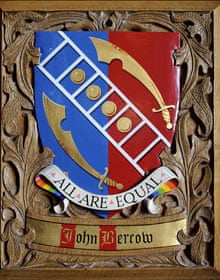
Aristocrats will be choking on their port. John Bercow, the Commons Speaker, has included a series of pink triangles and rainbow colours as part of his heraldic achievement to highlight his role in championing LGBT – lesbian, gay, bisexual and transgender – rights.
The Speaker's heraldry was unveiled on Monday at the same time as an official portrait. The coat of arms, developed by the College of Arms, tells the story of Bercow's journey from humble beginnings as the son of a taxi driver to become the most senior commoner in the land. The coat of arms features a ladder to represent his journey upwards. It features four roundels to represent his interest in tennis. The curved, notched blades of seaxes represent Essex where Bercow went to university.
And then the motto that will have the gentlemen spluttering in White's. The motto – All Are Equal – is separated by four pink triangles. Rainbow colours at the end of the scroll represent the flag of equality. The Taxpayers' Alliance, a group calling for tax and spending cuts, said it was "excessive" in an era of austerity for the Speaker to spend tens of thousands of pounds on a "vanity portrait". The official state portrait of Bercow, by Brendan Kelly, features him standing in front of the Speaker's chair issuing an instruction to MPs. Kelly said: "I wanted to capture the day to day reality of a Speaker mid-action at work in the Chamber. This meant black robes and a House of Commons tie, the iconic Speaker's chair prominent in the composition, books and papers on the shelves and the Speaker himself, shown animated in the midst of conducting the daily business of the House of Commons."